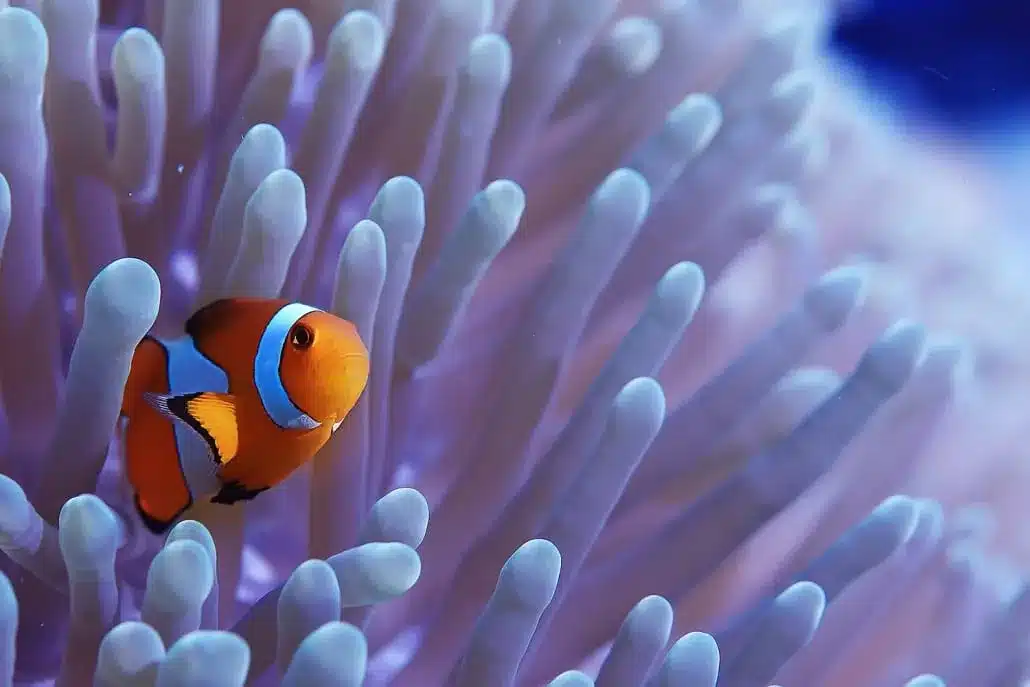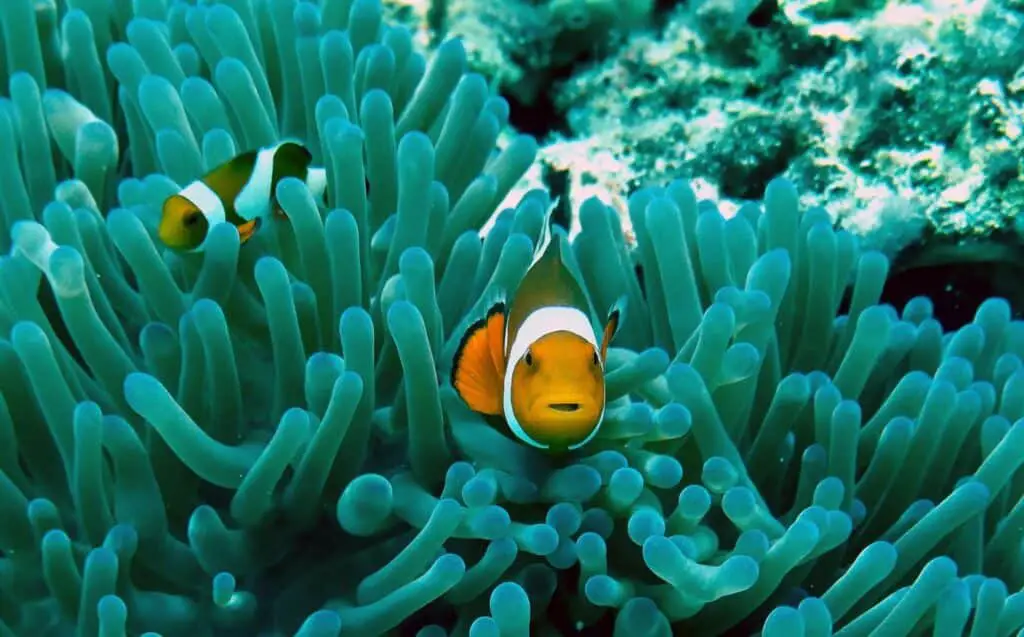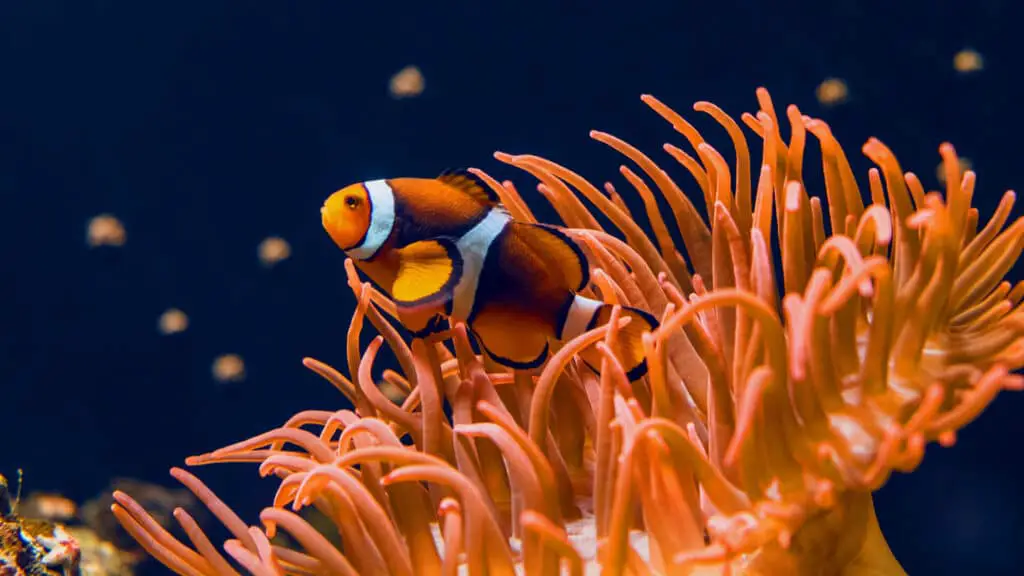Do Clownfish Live In Coral Reefs

Introduction
Do Clownfish Live In Coral Reefs: The mesmerizing world beneath the waves has long captivated our imagination, and few marine ecosystems are as enchanting as coral reefs. These underwater cities, constructed by tiny polyps over centuries, teem with life and color, making them a hotspot for biodiversity. Among the charismatic inhabitants of these coral wonderlands is the clownfish, a small but iconic species that has earned global recognition, thanks in part to a certain animated film.
Clownfish, scientifically known as Amphiprioninae, are remarkable creatures with distinctive colors and endearing behaviors. Their association with coral reefs has fascinated marine biologists and ocean enthusiasts for years. But do clownfish truly live in coral reefs, or is this a mere cinematic exaggeration?
We dive beneath the surface to unravel the truth about clownfish and their intricate relationship with coral reefs. We will embark on a journey to discover where these charismatic fish call home, how they navigate the perilous waters of the reef, and the unique partnership they share with their stinging neighbors, sea anemones.
To understand the lives of clownfish and their role within coral ecosystems, we must peel back the layers of the ocean’s mysteries. Join us on this underwater expedition as we seek to uncover the secrets of clownfish and their enchanting homes in the vibrant world of coral reefs.

Where do clownfish live in the coral reef?
Clownfish are found in warm waters, such as the Red Sea and Pacific Oceans, in sheltered reefs or lagoons, living in anemone. Clownfish eat various small invertebrates and algae, as well as food scraps the anemone leaves behind.
Within the coral reef itself, clownfish tend to seek shelter among the protective tentacles of sea anemones. This unique association benefits both the clownfish and the anemone. The clownfish find refuge from potential predators among the stinging anemone tentacles, while the anemone gains protection from certain herbivores thanks to the clownfish’s presence. This symbiotic relationship allows clownfish to carve out a safe haven within the sometimes perilous reef environment.
While clownfish primarily inhabit sea anemones, they are not confined to a single species of anemone. Different species of clownfish may prefer different types of anemones, and some species are known to inhabit several species of anemones within their range. This adaptability showcases the remarkable diversity and coexistence found within coral reef ecosystems.
Clownfish live in the intricate tapestry of coral reefs, finding sanctuary among the swaying arms of sea anemones. Their presence in these underwater havens highlights the interconnectedness of life within these vital marine ecosystems, making them a vital component of the mesmerizing world beneath the waves.
Why do clownfish live in coral reefs?
Clownfish live in mutually beneficial relationships with anemone. The clownfish protect the anemone from predators and provide food scraps. In return, the fish uses its bright colours to lure smaller fish into the anemone, where they are killed by the anemone’s poison and eaten.
Clownfish have evolved to live in coral reefs for a multitude of reasons, each tied to their survival and the unique dynamics of these underwater ecosystems. Here are some key reasons why clownfish have chosen to make coral reefs their home:
- Protection from Predators: Coral reefs can be perilous places, with numerous predators lurking among the corals. Clownfish have found safety by forming mutualistic relationships with sea anemones. These anemones provide protection, as their stinging tentacles deter many potential threats. Clownfish can swim among the anemone’s tentacles unharmed due to a special mucus covering their skin.
- Access to Food: Living within the protective embrace of sea anemones not only shields clownfish from danger but also provides them with a reliable source of food. Anemones capture prey using their stinging tentacles, and clownfish often feed on the scraps or small prey that the anemones catch.
- Breeding Grounds: Coral reefs offer a suitable environment for clownfish to lay their eggs and raise their young. The anemones’ protective shelter keeps the eggs and juvenile fish safe from predators.
- Nutrient Availability: Clownfish contribute to the health of the coral reef ecosystem by excreting waste.
Clownfish have intricately woven themselves into the fabric of coral reef life through their unique adaptations and behaviors, highlighting the incredible ways in which marine species have evolved to thrive in complex and challenging environments. Their presence not only enriches the reef ecosystem but also adds to the wonder of these underwater realms.
Do clownfish need live coral?
This is pretty common among clownfish grown in captivity. There is nothing really for you to fix in such a case, as corals and anemones are not even necessary in the first place. So, you could just leave them there, and if your clownfish do not end up liking your choice, they will just find another host.
Clownfish do not necessarily require live coral to survive, but they do have a strong association with coral reefs and often benefit from the presence of healthy coral colonies. Here’s an explanation of their relationship with live coral:
- Shelter and Protection: While clownfish are most famous for their mutualistic relationship with sea anemones, they can also seek refuge within the crevices and branches of live coral.
- Habitat Stability: Live coral reefs create a stable and complex habitat that supports the entire ecosystem of the reef. Coral structures offer nooks and crannies for clownfish to hide in, lay their eggs, and raise their young, contributing to their overall survival.
- Feeding Opportunities: Coral reefs are rich in biodiversity, and many species of fish, including clownfish, rely on the abundance of food sources found in and around the reef. Nutrient-rich waters near coral reefs attract zooplankton and other small prey, which can be an important food source for clownfish.
While clownfish can adapt to various environments, their close association with live coral is a testament to the intricate web of life within coral reef ecosystems. Protecting live coral is crucial not only for the survival of clownfish but for the entire marine ecosystem that depends on these magnificent underwater structures. The health of coral reefs is inextricably linked to the well-being of clownfish and countless other species that call these vibrant habitats home.
What eats clownfish in the coral reef?
This species is not considered to be threatened. Larger fish such as lionfish, snapper, grouper, triggers and eels will prey on clownfish.
Clownfish, made famous by the animated film “Finding Nemo,” inhabit coral reefs and enjoy a mutually beneficial relationship with sea anemones. Despite their charming appearance and protective homes, clownfish are not immune to predation in their coral reef environments. Several predators pose a threat to these colorful fish.
One of the primary natural threats to clownfish is larger fish species. Predators such as groupers, snappers, and wrasses often seek out clownfish as a tasty snack. These larger fish have the advantage of size and speed, making it challenging for clownfish to escape when they come too close.
In addition to fish, some invertebrates also feed on clownfish. Moray eels, known for their sharp teeth and impressive hunting skills, are another significant threat. These eels can slither into the crevices of coral reefs where clownfish seek refuge.
Lastly, some crustaceans, like mantis shrimp and arrow crabs, may prey on juvenile clownfish. These predators have powerful claws or spearing appendages that can capture small fish.
Despite these threats, clownfish have developed unique adaptations to survive in their coral reef homes, such as their ability to hide within the stinging tentacles of sea anemones. This protective partnership offers them some level of safety from potential predators while allowing them to thrive in the vibrant world of the coral reef.
Do clownfish lay eggs in coral?
They lay their orange eggs on rocks near the base of the Xenia elongata soft coral colony (to the right of the eggs in these photos) that they use as a surrogate host in the absence of a host anemone.
Clownfish do lay their eggs in coral reefs. This behavior is an integral part of their reproductive strategy and plays a crucial role in their life cycle. Clownfish are known for forming mutualistic relationships with certain species of sea anemones, which serve as their protective homes. These relationships are particularly beneficial during the breeding season.
When it comes time to lay eggs, female clownfish typically select a suitable sea anemone as their nesting site. They carefully prepare the chosen anemone’s surface by cleaning and clearing it of debris to create a clean, adhesive-friendly area. Once the nest is ready, the female clownfish deposits her eggs on the anemone’s surface.
The adhesive properties of the eggs allow them to stick to the anemone, providing them with protection from potential predators and water currents. Male clownfish are responsible for guarding and aerating the eggs to ensure their survival. They protect the nest by fanning the eggs with their fins and driving away any threats.
As the clownfish benefit from the protection offered by the anemones, and in return, they bring food to the anemones and help deter certain predators. This intricate reproductive strategy, which involves laying eggs in coral reefs within the protective embrace of sea anemones, is a fascinating example of the interconnectedness and adaptation of marine life in coral reef ecosystems.
How do clownfish survive in the coral reef?
Clownfish survive in a mutually assistive symbiotic relationship with anemone. The anemone protect the clownfish from predators and provide food scraps. In return, the clownfish uses its bright colours to lure fish into the anemone, where they are killed by the anemone’s poison and eaten.
Clownfish, known for their striking colors and unique behaviors, have developed a range of survival strategies that enable them to thrive in the challenging environment of the coral reef.
Mutualistic Relationship with Sea Anemones: One of the most remarkable adaptations of clownfish is their mutualistic symbiosis with certain species of sea anemones. Clownfish are immune to the stinging tentacles of these anemones.
Protective Behavior: Clownfish exhibit territorial and protective behavior, often fiercely defending their anemone homes. They may chase away intruders, including larger fish and potential egg predators.
Camouflage: Clownfish have the ability to change their coloration and adapt to the color of their host sea anemone. This camouflage helps them blend into their surroundings and avoid detection by predators.
Agile Swimmers: Clownfish are agile swimmers, darting in and out of the protective tentacles of their host anemones. Their rapid movements make it challenging for predators to catch them.
Breeding Strategies: Clownfish lay their eggs on the surface of sea anemones, where they receive protection from the anemones’ stinging tentacles. Male clownfish diligently guard and care for the eggs, ensuring their survival.
These survival strategies, combined with their close association with sea anemones and their adaptability, make clownfish well-suited for life in the coral reef, despite the many challenges posed by their diverse and dynamic marine ecosystem.
Why are clownfish important to coral reefs?
Clownfish receive a safe place to live and even prey to eat, and in return clownfish provide food to the anemone, help rid it of harmful parasites, and chase away fish like butterflyfish that feed on anemones.
Clownfish, those colorful and charismatic creatures made famous by the movie “Finding Nemo,” play a crucial role in the health and sustainability of coral reefs. Their importance to these vibrant underwater ecosystems cannot be overstated for several compelling reasons.
Firstly, clownfish have a mutualistic relationship with sea anemones, which are stationary, predatory animals. Clownfish are immune to the stinging tentacles of anemones and use them as shelter from predators. In return, clownfish offer food scraps and deter potential anemone-eating fish. This mutualism benefits both species and helps maintain the delicate balance of coral reef ecosystems.
Secondly, clownfish help with coral reef health by controlling algae growth. They consume small invertebrates and detritus around their anemone homes, preventing these organisms from overpopulating and smothering the coral. This herbivorous behavior contributes to the overall health and vitality of the reef ecosystem.
Clownfish are essential to coral reef ecosystems due to their mutualistic relationship with sea anemones, their role in controlling algae growth, and their significance in the marine food web. Protecting these charming fish is vital for the overall health and resilience of coral reefs worldwide.
Do clownfish hide in coral reefs?
Clownfish, known for their vibrant colors and distinctive patterns, are fascinating creatures that share a unique symbiotic relationship with coral reefs. These fish are predominantly found in the warm waters of the Pacific and Indian Oceans, nestled amidst the labyrinthine structures of coral reefs. Their choice of habitat is not arbitrary; it serves as both a sanctuary and a strategic location for survival.
Clownfish seek refuge within the protective arms of the corals, utilizing the intricate formations as natural shelters. The relationship between clownfish and corals is mutually beneficial. The clownfish gain protection from predators within the maze-like nooks and crannies, while the corals benefit from the nutrients in the fish’s waste, aiding in their growth and vitality.
These remarkable creatures have also developed a unique adaptation to their environment. Their skin secretes a mucus that allows them to safely navigate through the stinging tentacles of the corals, providing them with a level of immunity against potential harm.
Clownfish are territorial by nature, often establishing small colonies within specific coral formations. They exhibit a fascinating hierarchy, with a dominant female at the helm. In the event of her absence, the most dominant male will undergo a sex change and take her place, highlighting the adaptability and complexity of their social structure.

Conclusion
The captivating world of clownfish and coral reefs reveals a delicate dance between life forms in one of the ocean’s most remarkable ecosystems. Through our exploration, we have unveiled the undeniable truth that clownfish are indeed inhabitants of coral reefs, showcasing an intricate relationship that benefits both the fish and the corals.
The close association between clownfish and sea anemones is a testament to the remarkable adaptability of marine life. Clownfish find refuge within the stinging tentacles of anemones, gaining protection from predators while providing a source of food in return. This mutualistic partnership is a shining example of the interconnectedness of species within coral reef ecosystems.
Our journey has highlighted the essential role of clownfish in maintaining the health and diversity of these fragile habitats. As they dart among the corals, clownfish help to disperse nutrients and promote the growth of algae, which in turn benefits the entire reef community.
Understanding the symbiotic relationship between clownfish and coral reefs not only deepens our appreciation for the natural world but also underscores the importance of conservation efforts. With coral reefs facing numerous threats, including climate change and habitat destruction, it is imperative that we take action to preserve these vibrant underwater sanctuaries and the remarkable creatures that call them home, including the beloved clownfish.



